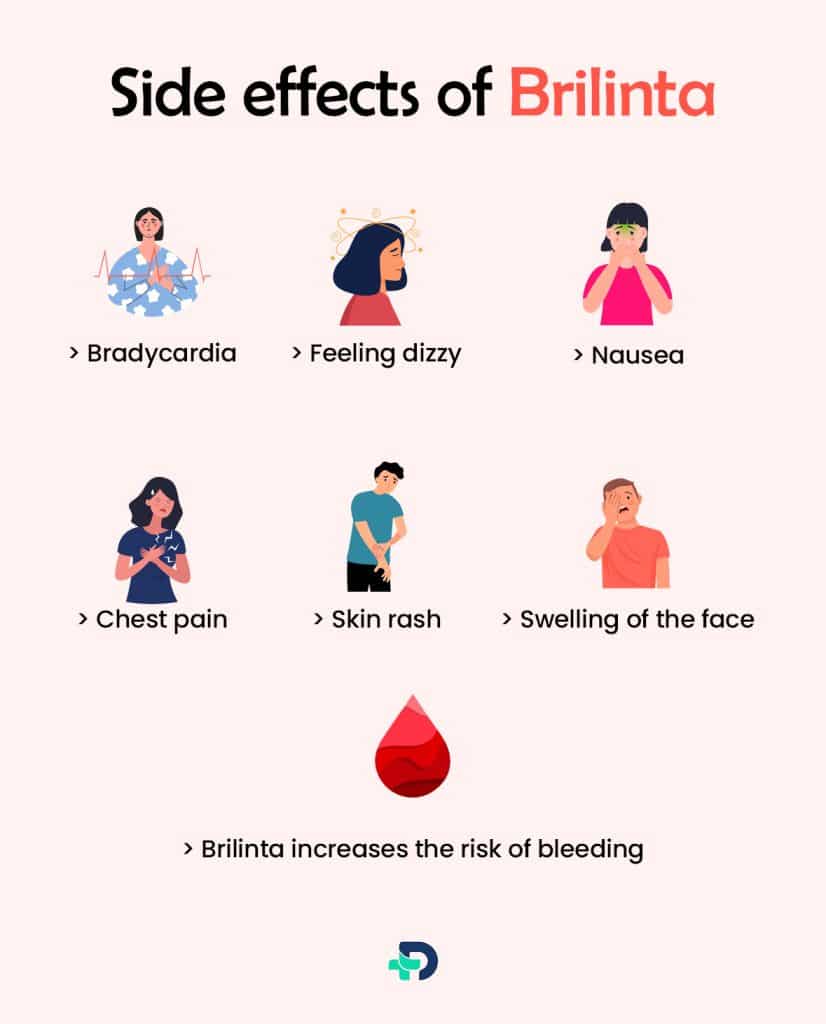BRILINTA: What do you need to know?

- Brilinta
- 17 Aug 2023
Overview
What is Brilinta?
Brilinta is a medicine classified as a P2Y12 platelet inhibitor. The brand name Brilinta contains Ticagrelor as the active component. FDA (Food and Drug Administration) first gave the green light in 2011.
It is prescribed to individuals with acute coronary syndrome (ACS) or a previous heart attack (myocardial infarction) to decrease the chances of cardiovascular death, heart attack, and stroke. It is also utilized for reducing the risk of blood clot formation in individuals with coronary artery disease, who have received stents to unblock narrowed arteries and improve blood flow to the heart.
Brilinta is often referred to as a “blood thinner” due to its ability to prevent blood clotting. Instead of being classified as an anticoagulant, Brilinta is technically classified as an antiplatelet medication. Its mechanism of action involves the inhibition of platelet aggregation, which decreases the likelihood of blood clotting.1Overview| Researched based study from Fda.gov

Uses
What is Brilinta used for?
Indications that have been approved by the FDA
- Treating Myocardial infarction
- Reduces chances of Cardiovascular death
- Preventing Strokes
- Reducing blood clot formation after stent placement
Cardiovascular death
- Brilinta (ticagrelor) plays a crucial role in reducing the rate of cardiovascular death by inhibiting platelet activation and preventing blood clot formation in individuals with acute coronary syndrome.
Myocardial infarction
- Brilinta is an important component of the treatment and prevention strategies for individuals at risk of myocardial infarction.
Stroke
- Brilinta is an important medication in the management and prevention of strokes in acute coronary syndrome (ACS) patients.
Stent thrombosis
- Stent placement is a common procedure performed during cardiac catheterization or angioplasty.
- After the insertion of stents, there is a risk of blood clot formation around the stent, known as stent thrombosis.
- Blood clots can lead to sudden blockages and potentially result in heart attacks or other cardiac events. Therefore, it is crucial to prevent clot formation and maintain stent patency.
- Brilinta plays a vital role in reducing the risk of blood clot formation in patients with coronary artery disease who have undergone stent placement.
- By inhibiting platelet activation and aggregation, Brilinta helps maintain blood flow through the stented arteries, preventing the formation of harmful blood clots. This lowers the risk of stent thrombosis2Uses| Researched based study from Lancastergeneralhealth.org
Mechanism
Mechanism of action of Brilinta
- The active components of a group of medications called thienopyridines, a type of antiplatelet drug, block a receptor called the adenosine diphosphate (ADP) receptor.
- However, Ticagrelor, the active ingredient in Brilinta, works differently. It attaches to a specific region on a receptor called P2Y12, which is different from where ADP normally binds.
- By doing this, Brilinta effectively prevents ADP from binding to the receptor. This action stops the transmission of signals and activation of platelets, which are small blood cells involved in clot formation.
- By preventing platelet activation, Brilinta assists in the deterrence of blood clot development.
- One unique feature of Brilinta is its reversible binding property. This means that it can move and attach to newly formed platelets, providing ongoing protection against clotting. 3Mechanism| Researched based study from Hmpgloballeraningnetwork.com
Dosage
Dosage and administration of Brilinta
- To start treatment after an acute coronary syndrome (ACS) event, begin with a high initial dose of 180 mg of Brilinta taken orally. Then, continue with a regular dose of 90 mg twice a day for the first year following the ACS event.5Dosage| Researched based study from Nhs.uk
- After one year, the dosage is lowered to 60 mg twice a day.
- It is essential to combine Brilinta with a daily prescribed dose of aspirin, usually ranging from 75-100 mg, for optimal effectiveness. This combination of medications helps maintain the desired effects and reduces the risk of blood clot formation.
- If a patient has difficulty swallowing whole tablets, they can crush Brilinta tablets and mix them with water to be consumed. Alternatively, the crushed tablet mixture can be administered through a nasogastric tube.4Dosage| Researched based study from Medlineplus.gov
Side effects

Side effects of Brilinta
- Brilinta increases the risk of bleeding
- Bradycardia (the heart beats at a slower rate than normal)
- Feeling dizzy
- Nausea
- Resting shortness of breath or experiencing it after minimal exercise or physical activity
- Chest pain
- Fast, slow, pounding, or irregular heartbeat
- Skin rash
- Swelling of the face, throat, tongue, lips, or eyes1Side effects| Researched based study from Fda.gov ,6Side effects| Researched based study from Nlm.nih.gov
Contraindications
Contraindications of Brilinta
History of bleeding in the brain
- Brilinta should not be used in patients who have a previous occurrence of bleeding in the brain (intracranial hemorrhage) due to the high risk of experiencing it again in this specific population.1Contraindications| Researched based study from Fda.gov
Ongoing Bleeding
- Brilinta should not be used in patients who are currently experiencing active pathological bleeding, such as bleeding ulcers or bleeding in the brain.
Allergic Reaction
- Brilinta should not be used in individuals who have experienced allergic reactions, including angioedema, to ticagrelor in the past.
Irregular heartbeat or lung disease
- Ticagrelor should not be used if one has a history of uncorrected irregular heartbeat despite having a pacemaker or if one has a lung disease such as chronic obstructive pulmonary disease (COPD) or asthma.
Pregnancy
- The doctor should be informed if pregnancy is present, if there are plans to become pregnant. If pregnancy occurs while taking ticagrelor, the doctor should be contacted.
Breastfeeding
- Considering the potential side effects Brilinta may have, a decision must be made between discontinuing breastfeeding or discontinuing the use of Brilinta.1Contraindications| Researched based study from Fda.gov
Pediatrics
- The efficacy and safety of Brilinta have not been determined in pediatric patients.
Hepatic Impairment
- It is recommended to refrain from using Brilinta in patients with severe liver impairment6Contraindications| Researched based study from Nlm.nih.gov
Interactions
Interactions of Brilinta
CYP3A Inhibitors
- Taking strong CYP3A inhibitors significantly raises the levels of ticagrelor in the body, which in turn increases the risk of experiencing dyspnea (shortness of breath), bleeding, and other negative effects.
- It is advised to avoid using potent CYP3A inhibitors like ketoconazole, atazanavir, ritonavir, etc. to minimize these risks.6Interactions| Researched based study from Nlm.nih.gov
CYP3A Inducers
- The use of strong CYP3A inducers significantly lowers the levels of ticagrelor in the body, leading to a decrease in its effectiveness.
- It is recommended to avoid using potent CYP3A inducers such as phenobarbital and rifampin, as they can reduce the efficacy of ticagrelor6Interactions| Researched based study from Nlm.nih.gov
Aspirin
- When Brilinta is utilized alongside aspirin doses for ongoing treatment exceeding 100 mg, it diminishes the efficacy of Brilinta.
Simvastatin and lovastatin
- Brilinta can raise the levels of simvastatin and lovastatin in the blood. It is advised to avoid taking doses of simvastatin and lovastatin greater than 40 mg when using Brilinta
Digoxin
- Brilinta affects the way digoxin is transported in the body. If you are taking digoxin along with Brilinta, it is important to monitor the levels of digoxin in your blood when you start or change your brilinta treatment.
Other interactions
Inform your doctor if you are using
- Antibiotics
- Cholesterol-lowering medications
- High blood pressure medications
- HIV medications like ritonavir
- Seizure medications like carbamazepine
- Medications for pain management.
Foods to avoid while taking Brilinta
- The consumption of grapefruit and grapefruit juice can influence the way Brilinta is metabolized, leading to an increased risk of bleeding. It is advised to refrain from ingesting grapefruit and its liquid extract.
- Consuming vegetables rich in Vitamin K may reduce the anticoagulant effects of Brilinta.
- It is advised to restrict the intake of vegetables that are rich in Vitamin K while taking Brilinta.
- The combination of consuming alcohol and taking Brilinta can increase the risk of bleeding as both substances can interfere with proper blood clotting. It is recommended to abstain from ingesting alcohol while taking brilinta1Interactions| Researched based study from Fda.gov
In the event that a dose is not taken as scheduled, what should be done?
- If ticagrelor is forgotten, it is advisable to administer the missed dose promptly upon recollection.
- If the upcoming planned administration of Brilinta is imminent, it is recommended to exclude the dose that is missed and proceed with the usual dosing timetable.
- It is not advisable to consume an extra dose of Brilinta in order to make up for a dose that is missed.
- If doses are often forgotten, it may be helpful to set an alarm to be reminded.
- Advice on other methods to remember taking the medication can be sought from the pharmacist.
Overdose
Toxicity caused by Brilinta overdose and its management
- At present, there is no known treatment available to reverse the effects of Brilinta, and it is unlikely that ticagrelor can be removed through dialysis.
- In the case of an overdose, standard medical practices should be followed for treatment.
- Bleeding is the anticipated result of excessive dosage, and in the event of bleeding, suitable measures of support should be implemented6Overdose| Researched based study from Nlm.nih.gov
- Platelet transfusion has been found ineffective in reversing the antithrombotic effect of Brilinta in individuals without health issues and is improbable to result in positive clinical outcomes for patients encountering bleeding.
- Overdose may also lead to digestive system symptoms such as queasiness, retching, and loose stools, along with pauses in ventricular activity.
- Continuous monitoring of the electrocardiogram (ECG) is recommended.
Takeaway
Key takeaways
- Brilinta (ticagrelor) is an effective medication for reducing the risk of cardiovascular events in patients with certain heart conditions, such as acute coronary syndrome.
- Brilinta has shown notable enhancements in various cardiovascular outcomes. Hence, healthcare professionals, including physicians, pharmacists, and nurse practitioners, ought to be knowledgeable about the appropriate use and contraindications of brilinta to ensure safe and effective treatment.
- Continuously monitoring patients throughout their treatment is crucial for effectively managing cardiovascular events.
Any feedback on this article?
 This Articles content was accurate
This Articles content was accurate Very Informative Article
Very Informative Article I have a question or a comment
I have a question or a comment
 This article contains inaccurate content
This article contains inaccurate content This article was not helpful
This article was not helpful I have a question or a comment
I have a question or a comment
We appreciate your helpful feedback!
Checkout our social pages
References
-
U.S.FOOD AND DRUG ADMINISTRATION
BRILINTA® | Overview | Interactions | Contraindications | Toxicity
-
Penn Medicine
How Long to Take Anti-Clotting Medications After Getting a Stent? | Uses
-
HMP Global
Brilinta Approved for Long-Term Use in Patients with History of Heart Attack | Uses
-
Medline Plus
Ticagrelor | Dosage
-
National Health Service
Ticagrelor | Dosage
-
National Library of Medicine
Foods to Avoid While Taking Brilinta | Interactions | Overdose






































